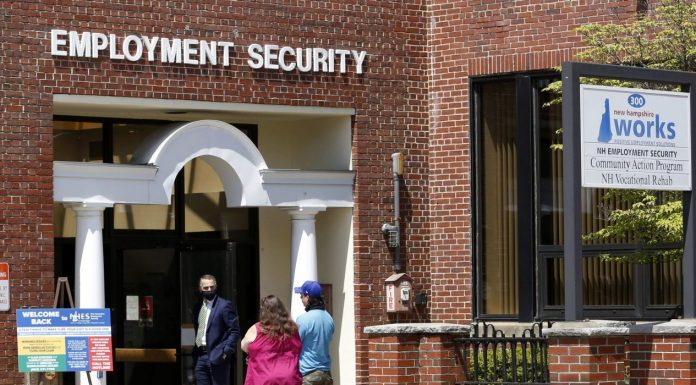() As the economy worsens, multiple industries continue to shed jobs.
The gaslighting Biden administration has often touted job growth reports. Yet those numbers frequently get revised downward. Moreover, many of the jobs are benefiting non-citizens exclusively. And all but one of the sectors in which jobs are gaining are government subsidized, meaning that the growth actually contributes to inflation.
U.S.-based companies laid off 82,307 employees in January, a 136% increase from the previous month, according to a report by the business and coaching firm Challenger, Gray & Christmas, Inc.
The Wall Street Journal reported companies were still cutting white-collar jobs in an attempt “to do more with less.”
With the exception of January 2023 job cuts, January 2024 job cuts were the highest announced for the month since January 2009, according to the Challenger report.
Layoff factors include 2024 being an election year and economic trends, said Andrew Challenger, SVP of Challenger, Gray & Christmas, Inc.
In an election year, “companies begin to plan for potential policy changes that may impact their industries.” But “layoffs are also driven by broader economic trends and a strategic shift towards increased automation and AI adoption in various sectors, though in most cases, companies point to cost-cutting as the main driver for layoffs.”
The financial sector announced the most job cuts in January of 23,238, the highest monthly total for the sector since September 2018, according to the report. The technology sector announced 15,806 cuts, the most since May 2023. The food production industry announced 6,656 layoffs, the highest since November 2012. Retailers announced 5,364 job cuts in January.
The media industry, including television, film, streaming, and news, announced 836 job cuts in January, down 24% from December 2023 but up 11% from January 2023.
Notably, the news sector, including digital, broadcast, and print, announced 528 layoffs in January, up 1,660% from December 2023, the report notes, with January 2024 cuts being the highest since March 2023.
This comes after multiple outlets have warned about the solvency of the news industry. Last year, more than 3,000 digital, broadcast and print news jobs were cut—the most since 2020, according to a December 2023 Challenger report. This year, the trend has continued.
The Texas Tribune, Los Angeles Times, Washington Post, Wall Street Journal, NowThis, the Intercept, Vox Media, NBC News, among others, recently announced layoffs. Vice dissolved its website and laid off hundreds of employees; BuzzFeed folded last year.
A Northwestern University Medill School of Journalism 2022 report suggested that one-third of U.S. newspapers existing 20 years ago would be out of business by 2025.
“The newspaper industry is collapsing and we’re at a point of no return—and magazines are even worse off,” Victor Pickard, a University of Pennsylvania professor of media policy, told The Guardian, citing lack of profit.
This comes after the Center Square reported last month on layoffs in the tech industry and by major companies, including Ford Motors, GM, UPS, Citigroup, Paramount Global, and Estée Lauder.
Other major chains—David’s Bridal, Sears, Foot Locker, CVS, Walgreens, Pizza Hut, Boston Market, Macy’s—also filed bankruptcies, or closed stores and announced layoffs.
As of Feb. 15, 149 tech companies laid off 39,000 employees, the Center Square reported. One month later, that number increased to 209 tech companies laying off 50,312 employees, according to Layoffs.fyi, a site that tracks technology sector layoffs.
Another Challenger report noted that nearly 1,200 CEOs left their jobs by the last quarter of 2023, a 51% increase from the previous year and the highest increase since it began tracking the data in 2002.
As a new Economic Policy Innovation Center brief warned that Americans’ purchasing power decreased because of high federal budget deficits driving inflation, economists also warned a recession is on the horizon.
This is as consumers added a record $50 billion in credit-card debt and total household debt reached a record $17.5 trillion in the fourth quarter of 2023, according to a Federal Reserve Bank of New York report.
Additionally, under the Biden administration, food stamp costs for family meals increased 31% over the past three years; car insurance rates increased 26% nationally, with some states reporting 44% increases in one year; home buyers currently need 80% more income to purchase a home than they did four years ago; and to combat hard economic times, one CEO recommended Americans eat cereal for dinner, the Center Square has reported.
President Joe Biden has blamed businesses for higher consumer costs, or “shrinkflation,” and has proposed taxing corporations to reduce the federal deficit. He also claimed he reduced the deficit, the Center Square reported and fact checked to be false.
The federal government began adding $1 trillion worth of debt about every 100 days beginning last June, the Center Square reported.
High budget deficits caused by federal government borrowing to spend more money it doesn’t have has fueled increased prices, the Economic Policy Innovation Center has explained. Fiscal hawks have called on Congress to rein in spending and implement other regulatory reforms.

